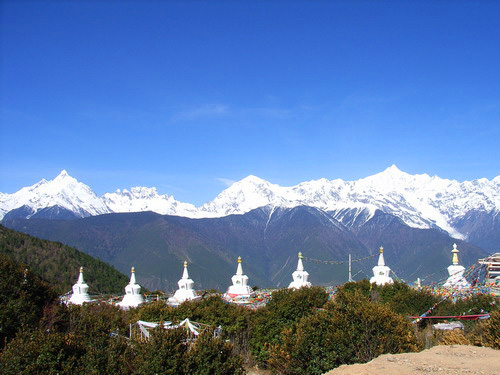|
Sanjiangyuan
The Sanjiangyuan ( zh, c=三江源, l=Source of Three Rivers), is an area of the Tibetan Plateau in Qinghai province, China which contains the headwaters of three great rivers of Asia: the Yellow, the Yangtze, and the Mekong. Parts of the area were protected as the Sanjiangyuan National Nature Reserve (SNNR), also called the Three Rivers Nature Reserve. The reserve consisted of 18 subareas, and each contained three zones which were managed with differing degrees of strictness. In 2015, the Chinese government decided to implement a new national park system; Sanjiangyuan National Park was the first national park to be established in the pilot program in late 2021. Along with wetland and waters protection, other ecological values, such as grassland, forest, and wildlife enhancement, have also been presented as goals. To advance the goals of the SNNR uncontrolled or poorly managed mining, logging, hunting, and grazing have been curtailed. Foreign and other mining firms have replaced ... [...More Info...] [...Related Items...] OR: [Wikipedia] [Google] [Baidu] |
Mekong
The Mekong or Mekong River ( , ) is a transboundary river in East Asia and Southeast Asia. It is the world's twelfth-longest river and the third-longest in Asia with an estimated length of and a drainage area of , discharging of water annually. From its headwaters in the Tibetan Plateau, the river runs through Southwest China (where it is officially called the Lancang River), Myanmar, Laos, Thailand, Cambodia, and southern Vietnam. The extreme seasonal variations in flow and the presence of rapids and waterfalls in the Mekong make navigation difficult, though the river remains a major trade route between Tibet and Southeast Asia. The construction of hydroelectric dams along the Mekong in the 2000s through the 2020s has caused serious problems for the river's ecosystem, including the exacerbation of drought. Names The Mekong was originally called ''Mae Nam Khong'' from a contracted form of Kra-Dai shortened to ''Mae Khong''. In Thai and Lao, ''Mae Nam'' ("Mother ... [...More Info...] [...Related Items...] OR: [Wikipedia] [Google] [Baidu] |
Golog Tibetan Autonomous Prefecture
Golog (Golok or Guoluo) Tibetan Autonomous Prefecture ( zh, c=果洛藏族自治州 , p=Guǒluò Zàngzú Zìzhìzhōu; ) is an autonomous prefecture occupying the southeastern corner of Qinghai province, China. The prefecture has an area of and its seat is located in Maqên County. Due to its special geographical location and natural environment, the entire autonomous preference has been included in the Chinese largest natural environmental protection area — the Sanjiangyuan National Park. Geography Golog Prefecture is located in the southeastern part of Qinghai, in the upper basin of the Yellow River. Gyaring Lake and Ngoring Lake on the western edge of the prefecture are considered to be the source of the Yellow River. However, these lakes do receive water from rivers that flow from locations even further west, in Qumarleb County of the Yushu Tibetan Autonomous Prefecture. The lay of the land of the prefecture is largely determined by the Amne Machin mountain range ( ... [...More Info...] [...Related Items...] OR: [Wikipedia] [Google] [Baidu] |
Amne Machin
Amne Machin, Anyi Machen, or Anyê Maqên ("Grandfather Pomra") is the highest peak of a mountain range of the same name in the southeast of Qinghai province, China. It is revered in Tibetan Buddhism as the home of the chief indigenous deity of Amdo, Machen Pomra. Geography The entire Amne Machin range is an eastern extension of the Kunlun Mountains, a major mountain system of Asia. The Amne Machin range runs in the general northwest-to-southeast direction in eastern Qinghai ( Golog Tibetan Autonomous Prefecture and the adjacent areas of the Hainan Tibetan Autonomous Prefecture) and the southwestern corner of Gansu's Gannan Tibetan Autonomous Prefecture. The existence of the ridge results in one of the great bends of the Yellow River. The river first flows for several hundreds of kilometers toward the east and southeast, along the south-western side of the Amne Machin Range. In so doing it crosses the entire length of Golog Prefecture, and reaches the borders of Gansu and Si ... [...More Info...] [...Related Items...] OR: [Wikipedia] [Google] [Baidu] |
Yellow River
The Yellow River, also known as Huanghe, is the second-longest river in China and the List of rivers by length, sixth-longest river system on Earth, with an estimated length of and a Drainage basin, watershed of . Beginning in the Bayan Har Mountains, the river flows generally eastwards before entering the long Ordos Loop, which runs northeast at Gansu through the Ordos Plateau and turns east in Inner Mongolia. The river then turns sharply southwards to form the border between Shanxi and Shaanxi, turns eastwards at its confluence with the Wei River, and flows across the North China Plain before emptying into the Bohai Sea. The river is named for the yellow color of its water, which comes from the large amount of sediment discharged into the water as the river flows through the Loess Plateau. The Yellow River basin was the birthplace of Yellow River civilization, ancient Chinese civilization. According to traditional Chinese historiography, the Xia dynasty originated on it ... [...More Info...] [...Related Items...] OR: [Wikipedia] [Google] [Baidu] |
Yangtze
The Yangtze or Yangzi ( or ) is the longest river in Eurasia and the third-longest in the world. It rises at Jari Hill in the Tanggula Mountains of the Tibetan Plateau and flows including Dam Qu River the longest source of the Yangtze, in a generally easterly direction to the East China Sea. It is the fifth-largest primary river by discharge volume in the world. Its drainage basin comprises one-fifth of the land area of China, and is home to nearly one-third of the country's population. The Yangtze has played a major role in the history, culture, and economy of China. For thousands of years, the river has been used for water, irrigation, sanitation, transportation, industry, boundary-marking, and war. The Yangtze Delta generates as much as 20% of China's GDP, and the Three Gorges Dam on the Yangtze is the largest hydro-electric power station in the world. In mid-2014, the Chinese government announced it was building a multi-tier transport network, comprising railway ... [...More Info...] [...Related Items...] OR: [Wikipedia] [Google] [Baidu] |
Three Parallel Rivers
The Three Parallel Rivers of Yunnan Protected Areas () is a UNESCO World Heritage Site in Yunnan province, China. It lies within the drainage basins of the upper reaches of the Jinsha (Yangtze), Lancang (Mekong) and Nujiang (Salween) rivers, in the Yunnan section of the Hengduan Mountains. Overview Geography The protected areas extend over 15 core areas, totalling 939,441.4 ha, and buffer areas, totalling 758,977.8 ha across a region of 180 km by 310 km. Here, for a distance of over 300 km, three of Asia's great rivers run roughly parallel to one another though separated by high mountain ranges with peaks over 6,000 meters. After this area of near confluence, the rivers greatly diverge: the Nujiang River becomes Salween and empties out at Moulmein, Burma, into the Indian Ocean; the Lancang becomes the Mekong and empties at south of Ho Chi Minh City, Vietnam into the South China Sea; and the Yangtze flows into the East China Sea at Shanghai. Selected nat ... [...More Info...] [...Related Items...] OR: [Wikipedia] [Google] [Baidu] |
Yushu Tibetan Autonomous Prefecture
Yushu Tibetan Autonomous Prefecture (, zh, s=玉树藏族自治州, p=Yùshù Zàngzú Zìzhìzhōu, retranscribed into Tibetan as ), also transliterated as Yüxü or Yulshul, is an autonomous prefecture of Southwestern Qinghai Province, China. Largely inhabited by Tibetans, the prefecture has an area of and its seat is located in the town of Gyêgu in Yushu County, which is the place of the old Tibetan trade mart of Jyekundo. The official source of the Yellow River lies within the prefecture. Historically, the area belongs to the cultural realm of Kham in Eastern Tibet. On 14 April 2010, an earthquake struck the prefecture, registering a magnitude of 6.9 (USGS, EMSC) or 7.1About 400 dead, 10,000 injured in 7. ... [...More Info...] [...Related Items...] OR: [Wikipedia] [Google] [Baidu] |
Qinghai
Qinghai is an inland Provinces of China, province in Northwestern China. It is the largest provinces of China, province of China (excluding autonomous regions) by area and has the third smallest population. Its capital and largest city is Xining. Qinghai borders Gansu on the northeast, Xinjiang on the northwest, Sichuan on the southeast and the Tibet Autonomous Region on the southwest. Qinghai province was established in 1928 during the period of the Republic of China (1912–1949), Republic of China, and until 1949 was ruled by Hui people, Chinese Muslim warlords known as the Ma clique. The Chinese language, Chinese name "Qinghai" is after Qinghai Lake, the largest lake in China. The lake is known as Tso ngon in Tibetan, and as Kokonor Lake in English, derived from the Mongol Oirat language, Oirat name for Qinghai Lake. Both Tso ngon and Kokonor are names found in historic documents to describe the region.Gangchen Khishong, 2001. ''Tibet and Manchu: An Assessment of Tibet-Man ... [...More Info...] [...Related Items...] OR: [Wikipedia] [Google] [Baidu] |
Center For Strategic And International Studies
The Center for Strategic and International Studies (CSIS) is an American think tank based in Washington, D.C. From its founding in 1962 until 1987, it was an affiliate of Georgetown University, initially named the Center for Strategic and International Studies of Georgetown University. The center conducts policy studies and strategic analyses of political, economic and security issues throughout the world, with a focus on issues concerning international relations, trade, technology, finance, energy and geostrategy. Since its founding, CSIS "has been dedicated to finding ways to sustain American prominence and prosperity as a force for good in the world", according to its website. CSIS is officially a bipartisan think tank with scholars that represent varying points of view across the political spectrum. It is known for inviting well-known foreign policy and public service officials from the U.S. Congress and the executive branch, including those affiliated with either the Democ ... [...More Info...] [...Related Items...] OR: [Wikipedia] [Google] [Baidu] |
Hainan Tibetan Autonomous Prefecture
Hainan Tibetan Autonomous Prefecture, formerly known as Tsolho Tibetan Autonomous Prefecture ( zh, c=海南藏族自治州; ), is an autonomous prefecture of Northeastern Qinghai Province in Western China. The prefecture has an area of and its seat is located in Gonghe County. Its name literally means "south of (Qinghai) Lake." History The land of Hainan prefecture was originally inhabited by the Qiang and Rong people. During the Western Han it was incorporated in the Chinese dynasties. In 60 BC, Guide County was established, then called Guan County. It was governed under Jincheng (present day Lanzhou). Demographics In 2019, the prefecture had 478,000 inhabitants, with 331,995 belonging to ethnic minorities. The following is a list of ethnic groups in the prefecture, as of 2019. Administrative divisions Hainan Prefecture was established in 1953. The prefecture is subdivided into 5 county-level divisions (5 counties): Geography Hainan is rather mountainous, w ... [...More Info...] [...Related Items...] OR: [Wikipedia] [Google] [Baidu] |
Jigzhi County
Jigzhi County or Chik Dril (; zh, s=久治县) is a county of Qinghai Province, China, bordering Sichuan to the southeast and Gansu to the northeast. It is under the administration of Golog Tibetan Autonomous Prefecture. The seat of Jigzhi County is in the Town of Chugqênsumdo. Administrative divisions Jigzhi is divided into one town and five townships: Climate Jigzhi County has a dry-winter subarctic climate (''Dwc'') See also * List of administrative divisions of Qinghai Qinghai, a province of the People's Republic of China, is made up of the following administrative divisions. Administrative divisions All of these administrative divisions are explained in greater detail at Administrative divisions of the People ... References External links County-level divisions of Qinghai Golog Tibetan Autonomous Prefecture {{Qinghai-geo-stub ... [...More Info...] [...Related Items...] OR: [Wikipedia] [Google] [Baidu] |








